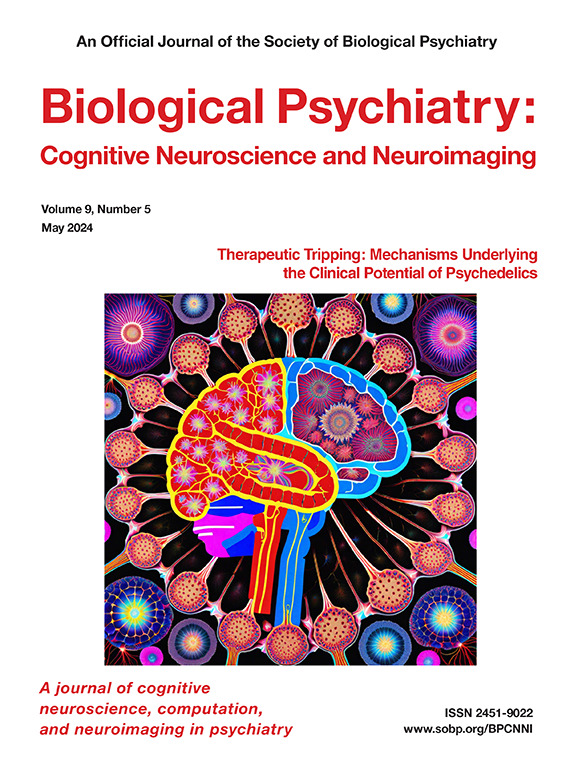Decomposing the Brain in Autism: Linking Behavioral Domains to Neuroanatomical Variation and Genomic Underpinnings
IF 4.8
2区 医学
Q1 NEUROSCIENCES
Biological Psychiatry-Cognitive Neuroscience and Neuroimaging
Pub Date : 2025-10-01
DOI:10.1016/j.bpsc.2024.12.003
引用次数: 0
Abstract
Background
Autism is accompanied by highly individualized patterns of neurodevelopmental differences in brain anatomy. This variability makes the neuroanatomy of autism inherently difficult to describe at the group level. Here, we examined interindividual neuroanatomical differences using a dimensional approach that decomposed the domains of social communication and interaction (SCI), restricted and repetitive behaviors (RRBs), and atypical sensory processing (ASP) within a neurodiverse study population. Moreover, we aimed to link the resulting neuroanatomical patterns to specific molecular underpinnings.
Methods
Neurodevelopmental differences in cortical thickness (CT) and surface area (SA) were correlated with SCI, RRB, and ASP domain scores by regression of a general linear model in a large neurodiverse sample of 288 autistic individuals and 140 nonautistic individuals, ages 6 to 30 years, recruited within the European Autism Interventions Longitudinal European Autism Project (EU-AIMS LEAP). The domain-specific patterns of neuroanatomical variability were subsequently correlated with cortical gene expression profiles via the Allen Human Brain Atlas.
Results
Across groups, behavioral variations in SCI, RRBs, and ASP were associated with interindividual differences in CT and SA in partially non-overlapping frontoparietal, temporal, and occipital networks. These domain-specific imaging patterns were enriched for genes that 1) are differentially expressed in autism, 2) mediate typical brain development, and 3) are associated with specific cortical cell types. Many of these genes were implicated in pathways governing synaptic structure and function.
Conclusions
Our study corroborates the close relationship between neuroanatomical variation and interindividual differences in autism-related symptoms and traits within the general framework of neurodiversity and links domain-specific patterns of neuroanatomical differences to putative molecular underpinnings.
分解自闭症中的大脑:将行为领域与神经解剖变异和基因组基础联系起来。
背景:自闭症伴随着高度个性化的大脑解剖学神经发育差异模式。这种差异性使得自闭症的神经解剖学很难在群体层面上进行描述。在此,我们采用一种维度方法,对神经多样性研究人群中的社会交流和互动(SCI)、限制性和重复性行为(RRB)以及非典型感觉处理(ASP)等领域进行分解,从而研究个体间的神经解剖学差异。此外,我们还旨在将由此得出的神经解剖模式与特定的分子基础联系起来:方法:在欧盟-AIMS 欧洲自闭症纵向项目(LEAP)中招募了大量神经多样性样本,其中包括 288 名自闭症患者和 140 名非自闭症患者,年龄在 6-30 岁之间,通过回归一般线性模型,将皮层厚度和表面积的神经发育差异与 SCI、RRB 和 ASP 领域得分相关联。随后,通过 Allan 人类脑图谱将特定领域的神经解剖变异模式与皮层基因表达谱进行了关联:结果:在各组中,SCI、RRB 和 ASP 的行为差异与部分不重叠的前顶叶、颞叶和枕叶网络中 CT 和 SA 的个体间差异相关。这些特定领域的成像模式富含以下基因:(i) 在自闭症中表达不同;(ii) 介导典型的大脑发育;(iii) 与特定的皮层细胞类型相关。其中许多基因与突触结构和功能的调节途径有关:我们的研究证实了在神经多样性的总体框架内,神经解剖学变异与自闭症相关症状和特征的个体差异之间的密切关系,并将特定领域的神经解剖学差异模式与推测的分子基础联系起来。
本文章由计算机程序翻译,如有差异,请以英文原文为准。
求助全文
约1分钟内获得全文
求助全文
来源期刊

Biological Psychiatry-Cognitive Neuroscience and Neuroimaging
Neuroscience-Biological Psychiatry
CiteScore
10.40
自引率
1.70%
发文量
247
审稿时长
30 days
期刊介绍:
Biological Psychiatry: Cognitive Neuroscience and Neuroimaging is an official journal of the Society for Biological Psychiatry, whose purpose is to promote excellence in scientific research and education in fields that investigate the nature, causes, mechanisms, and treatments of disorders of thought, emotion, or behavior. In accord with this mission, this peer-reviewed, rapid-publication, international journal focuses on studies using the tools and constructs of cognitive neuroscience, including the full range of non-invasive neuroimaging and human extra- and intracranial physiological recording methodologies. It publishes both basic and clinical studies, including those that incorporate genetic data, pharmacological challenges, and computational modeling approaches. The journal publishes novel results of original research which represent an important new lead or significant impact on the field. Reviews and commentaries that focus on topics of current research and interest are also encouraged.
 求助内容:
求助内容: 应助结果提醒方式:
应助结果提醒方式:


